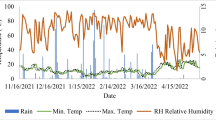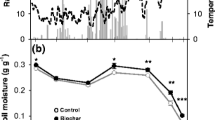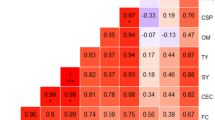Abstract
Purpose
The agriculture industry is under intense pressure to produce more food with a lower environmental impact, while also mitigating climate change. Biochar has the potential to improve food security while improving soil fertility and sequestering carbon. The aim of our research was to evaluate the effects of apple branch biochar on wheat yield and soil nutrients under different nitrogen (N) and water conditions.
Materials and methods
Durum wheat was grown for nearly 6 months in pots with silt clay soil supplemented with apple branch biochar. The biochar was applied at five rates (0, 1, 2, 4, and 6% w/w; B0, B1, B2, B3, and B4), and N fertilizer was applied at three rates (0, 0.2, and 0.4 g kg−1; N0, N1, and N2). From the jointing to maturation stages, the soil water content was controlled at two rates to simulate sufficient water and drought conditions (75 and 45% of field capacity; W1 and W2). After harvest, we investigated grain yield and soil nutrient status.
Results and discussion
The application of biochar alone had a positive effect on wheat production and soil nutrients, especially under sufficient water conditions. Compared with the addition of N fertilizer alone, the addition of biochar at B1 and B2 combined with N fertilizer under sufficient water conditions increased the crop yield by 7.40 to 12.00%, whereas this was not the case under drought stress. Furthermore, regardless of water conditions, compared with N fertilizer application alone, a high rate of biochar application (B3 and B4) led to a significant decrease in the grain yield of approximately 6.25–21.83%. Biochar had strong effects on soil nutrients, with NO3− and available phosphorus contents and the C:N ratio exerting the greatest effects on wheat yield.
Conclusions
The effects of biochar on wheat production and soil nutrients varied with the biochar application rate, N fertilizer application rate, and water conditions. Drought stress weakened or offset the positive effect of biochar on crop production, especially under the high-N level (N2) conditions. The optimum application combination was 1% (or possibly even less) apple branch biochar (B1) and moderate N fertilizer (N1).



Similar content being viewed by others
References
Alburquerque JA, Salazar P, Barron V, Torrent J, del Campillo MD, Gallardo A, Villar R (2013) Enhanced wheat yield by biochar addition under different mineral fertilization levels. Agron Sustain Dev 33:475–484
Asai H, Samson BK, Stephan HM, Songyikhangsuthor K, Homma K, Kiyono Y, Inoue Y, Shiraiwa T, Horie T (2009) Biochar amendment techniques for upland rice production in Northern Laos: 1. Soil physical properties, leaf SPAD and grain yield. Field Crop Res 111:81–84
Baiamonte G, Pasquale CD, Marsala V, Cimò G, Alonzo G, Crescimanno G, Conte P (2015) Structure alteration of a sandy-clay soil by biochar amendments. J Soils Sediments 15:816–824
Bayabil HK, Stoof CR, Lehmann JC, Yitaferu B, Steenhuis TS (2015) Assessing the potential of biochar and charcoal to improve soil hydraulic properties in the humid Ethiopian highlands: the Anjeni watershed. Geoderma 243–244:115–123
Brassard P, Godbout S, Raghavan V (2016) Soil biochar amendment as a climate change mitigation tool: key parameters and mechanisms involved. J Environ Manag 181:484–497
Bremmer JM, Mulvaney CS (1982) Nitrogen - total. In: Page AL (ed) Methods of soil analysis, Agron. Monogr. 9, 2nd edn. ASA and SSSA, Madison, pp 595–624
Clare A, Shackley S, Joseph S, Hammond J, Pan G, Bloom A (2015) Competing uses for China’s straw: the economic and carbon abatement potential of biochar. GCB Bioenergy 7:1272–1282
Cranedroesch A, Abiven S, Jeffery S, Torn MS (2013) Heterogeneous global crop yield response to biochar: a meta-regression analysis. Environ Res Lett 8:925–932
Ding Y et al (2016) Biochar to improve soil fertility. A review. Agron Sustain Dev 36:18
Eykelbosh AJ, Johnson MS, Couto EG (2015) Biochar decreases dissolved organic carbon but not nitrate leaching in relation to vinasse application in a Brazilian sugarcane soil. J Environ Manag 149:9–16
Farrell M, Macdonald LM, Butler G, Chirino-Valle I, Condron LM (2014) Biochar and fertiliser applications influence phosphorus fractionation and wheat yield. Biol Fertil Soils 50:169–178
Galinato SP, Yoder JK, Granatstein D (2011) The economic value of biochar in crop production and carbon sequestration. Energ Policy 39:6344–6350
Githinji L (2013) Effect of biochar application rate on soil physical and hydraulic properties of a sandy loam. Arch Agron Soil Sci 60:457–470
Gul S, Whalen JK (2016) Biochemical cycling of nitrogen and phosphorus in biochar-amended soils. Soil Biol Biochem 103:1–15
Gul S, Whalen JK, Thomas BW, Sachdeva V, Deng H (2015) Physico-chemical properties and microbial responses in biochar-amended soils: mechanisms and future directions. Agric Ecosyst Environ 206:46–59
Haider G, Steffens D, Muller C, Kammann CI (2016) Standard extraction methods may underestimate nitrate stocks captured by field-aged biochar. J Environ Qual 45:1196–1204
Hansen V, Hauggaard-Nielsen H, Petersen CT, Mikkelsen TN, Müller-Stöver D (2016) Effects of gasification biochar on plant-available water capacity and plant growth in two contrasting soil types. Soil Tillage Res 161:1–9
Ibrahim et al (2013) Effect of Conocarpus biochar application on the hydraulic properties of a sandy loam soil. Soil Sci 178:165–173
Jassal RS, Johnson MS, Molodovskaya M, Black TA, Jollymore A, Sveinson K (2015) Nitrogen enrichment potential of biochar in relation to pyrolysis temperature and feedstock quality. J Environ Manag 152:140–144
Jin Y, Liang XQ, He MM, Liu Y, Tian GM, Shi JY (2016) Manure biochar influence upon soil properties, phosphorus distribution and phosphatase activities: a microcosm incubation study. Chemosphere 142:128–135
Joseph S, Graber ER, Chia C, Munroe P, Donne S, Thomas T, Nielsen S, Marjo C, Rutlidge H, Pan GX, Li L, Taylor P, Rawal A, Hook J (2013) Shifting paradigms: development of high-efficiency biochar fertilizers based on nano-structures and soluble components. Carbon Manage 4:323–343
Joseph S, Kammann CI, Shepherd JG, Conte P, Schmidt HP, Hagemann N, Rich AM, Marjo CE, Allen J, Munroe P, Mitchell DRG, Donne S, Spokas K, Graber ER (2018) Microstructural and associated chemical changes during the composting of a high temperature biochar: mechanisms for nitrate, phosphate and other nutrient retention and release. Sci Total Environ 618:1210–1223
Kammann CI et al (2015a) Erratum: plant growth improvement mediated by nitrate capture in co-composted biochar. Sci Rep 5:11080
Kammann CI et al (2015b) Plant growth improvement mediated by nitrate capture in co-composted biochar. Sci Rep 5:11080
Kuppusamy S, Thavamani P, Megharaj M, Venkateswarlu K, Naidu R (2016) Agronomic and remedial benefits and risks of applying biochar to soil: current knowledge and future research directions. Environ Int 87:1–12
Laird DA, Fleming P, Davis DD, Horton R, Wang BQ, Karlen DL (2010) Impact of biochar amendments on the quality of a typical Midwestern agricultural soil. Geoderma 158:443–449
Lehmann J, Joseph S (2009) Biochar for environmental management, vol 25, Science and technology. Earthscan, London, Sterling, pp 15801–15811
Lehmann J, Rillig MC, Thies J, Masiello CA, Hockaday WC, Crowley D (2011) Biochar effects on soil biota—a review. Soil Biol Biochem 43:1812–1836
Li S, Liang C, Shangguan Z (2017) Effects of apple branch biochar on soil C mineralization and nutrient cycling under two levels of N. Sci Total Environ 607:109–119
Lu W, Ding W, Zhang J, Li Y, Luo J, Bolan N, Xie Z (2014) Biochar suppressed the decomposition of organic carbon in a cultivated sandy loam soil: a negative priming effect. Soil Biol Biochem 76:12–21
Mohammadi A, Cowie AL, Cacho O, Kristiansen P, Anh Mai TL, Joseph S (2017) Biochar addition in rice farming systems: economic and energy benefits. Energy 140:415–425
Mukherjee A, Lal R (2014) The biochar dilemma. Soil Res 52:217–230
Mukherjee A, Zimmerman AR (2013) Organic carbon and nutrient release from a range of laboratory-produced biochars and biochar–soil mixtures. Geoderma 193–194:122–130
Nelson DW, Sommers LE (1982) Total carbon, organic carbon and organic matter, In: Page AL, Miller RH, Keeney DR (eds) Methods of soil analysis, part 2, 2nd edn. Agronomy Monograph, vol. 9. ASA and SSSA, Madison, pp 534–580
Olmo M, Villar R, Salazar P, Alburquerque JA (2016) Changes in soil nutrient availability explain biochar’s impact on wheat root development. Plant Soil 399:333–343
Pan GX et al (2015) Industrialization of biochar from biomass pyrolysis: a new option for straw burning ban and green agriculture of China. Sci. Technol Rev 33:92–101
Pratiwi EPA, Hillary AK, Fukuda T, Shinogi Y (2016) The effects of rice husk char on ammonium, nitrate and phosphate retention and leaching in loamy soil. Geoderma 277:61–68
Qian L, Chen L, Joseph S, Pan G, Li L, Zheng J, Zhang X, Zheng J, Yu X, Wang J (2014) Biochar compound fertilizer as an option to reach high productivity but low carbon intensity in rice agriculture of China. Carbon Manag 5:145–154
Rajkovich S, Enders A, Hanley K, Hyland C, Zimmerman AR, Lehmann J (2012) Corn growth and nitrogen nutrition after additions of biochars with varying properties to a temperate soil. Biol Fertil Soils 48:271–284
Rockström J, Lannerstad M, Falkenmark M (2007) Assessing the water challenge of a new green revolution in developing countries. Proc Natl Acad Sci U S A 104:6253–6260
Schimel DS (2010) Drylands in the earth system. Science 327:418–419
Schulz H, Glaser B (2012) Effects of biochar compared to organic and inorganic fertilizers on soil quality and plant growth in a greenhouse experiment. J Plant Nutr Soil Sci 175:410–422
Schulz H, Dunst G, Glaser B (2014) No effect level of co-composted biochar on plant growth and soil properties in a greenhouse experiment. Agronomy 4:34–51
Sdc C, Mcnamara NP, Reay DS, Whitaker J (2012) The effect of biochar addition on N2O and CO2 emissions from a sandy loam soil—the role of soil aeration. Soil Biol Biochem 51:125–134
Sohi SP, Krull E, Lopez-Capel E, Bol R (2010) A review of biochar and its use and function in soil. In: Sparks DL (ed) Advances in Agronomy, vol 105. Elsevier Academic Press Inc, San Diego, pp 47–82. https://doi.org/10.1016/s0065-2113(10)05002-9
Spokas KA, Novak JM, Stewart CE, Cantrell KB, Uchimiya M, Dusaire MG, Ro KS (2011) Qualitative analysis of volatile organic compounds on biochar. Chemosphere 85:869–882
Sui Y, Gao J, Liu C, Zhang W, Lan Y, Li S, Meng J, Xu Z, Tang L (2016) Interactive effects of straw-derived biochar and N fertilization on soil C storage and rice productivity in rice paddies of Northeast China. Sci Total Environ 544:203–210
Uzoma KC, Inoue M, Andry H, Fujimaki H, Zahoor A, Nishihara E (2011) Effect of cow manure biochar on maize productivity under sandy soil condition. Soil Use Manag 27:205–212
Yao C et al (2015) Developing more effective enhanced biochar fertilisers for improvement of pepper yield and quality. Pedosphere 25:703–712
Yao Q, Liu J, Yu Z, Li Y, Jin J, Liu X, Wang G (2017) Three years of biochar amendment alters soil physiochemical properties and fungal community composition in a black soil of Northeast China. Soil Biol Biochem 110:56–67
Yoo G, Kim H, Chen J, Kim Y (2014) Effects of biochar addition on nitrogen leaching and soil structure following fertilizer application to rice paddy soil. Soil Sci Soc Am J 78:852–860
Zheng J, Han J, Liu Z, Xia W, Zhang X, Li L, Liu X, Bian R, Cheng K, Zheng J, Pan G (2017) Biochar compound fertilizer increases nitrogen productivity and economic benefits but decreases carbon emission of maize production. Agric Ecosyst Environ 241:70–78
Zimmerman AR, Gao B, Ahn MY (2011) Positive and negative carbon mineralization priming effects among a variety of biochar-amended soils. Soil Biol Biochem 43:1169–1179
Zwieten LV et al (2010) Effects of biochar from slow pyrolysis of papermill waste on agronomic performance and soil fertility. Plant Soil 327:235–246
Funding
This work was supported by the National Key Technology R&D Program of China (2016YFC0501605 and 2015BAD22B01).
Author information
Authors and Affiliations
Corresponding author
Additional information
Responsible editor: Hailong Wang
Electronic supplementary material
Fig. S1
The monthly mean air temperature during wheat growth (GIF 29 kb)
Rights and permissions
About this article
Cite this article
Li, S., Shangguan, Z. Positive effects of apple branch biochar on wheat yield only appear at a low application rate, regardless of nitrogen and water conditions. J Soils Sediments 18, 3235–3243 (2018). https://doi.org/10.1007/s11368-018-1994-3
Received:
Accepted:
Published:
Issue Date:
DOI: https://doi.org/10.1007/s11368-018-1994-3




